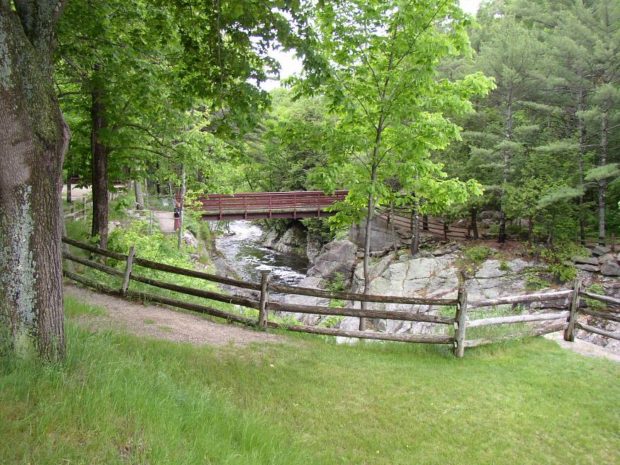
| Year | Population |
|---|---|
| 1970 | 1,171 |
| 1980 | 1,390 |
| 1990 | 1,514 |
| 2000 | 1,722 |
| 2010 | 1,812 |
| Geographic Data | |
|---|---|
| N. Latitude | 44:19:31 |
| W. Longitude | 70:31:30 |
| Maine House | District 71 |
| Maine Senate | District 18 |
| Congress | District 2 |
| Area sq. mi. | (total) 24.4 |
| Area sq. mi. | (land) 24.3 |
| Population/sq.mi. | (land) 74.6 |
County: Oxford
Total=land+water; Land=land only |
|
[PAHR-iss] is a town in Oxford County, settled in 1779 and incorporated in September, 1957. The community, north and west of Paris via Route 26, though small, has experienced consistent population growth over the past thirty years.
North Paris village is in the north eastern portion of the town on Route 219, near the 96-acre Moose Pond. The shallow (10 feet) pond is friendly to warmwater fish, including largemouth bass, yellow perch and chain pickerel. A state sponsored boat launch is located near the outlet dam.
Snow Falls, a 40 foot waterfall, drops into a gorge created by the Little Androscoggin River about two mile south of West Paris village. The River is an outlet of Bryant Pond in adjoining Woodstock.
Form of Government: Town Meeting-Select Board-Manager.
Additional resources
Barnes, Diane. The Oxford Hills: Greenwood, Norway, Oxford, Paris, West Paris and Woodstock. Dover, N.H. Arcadia Publishing. c1995.
*Maine. Historic Preservation Commission. Augusta, Me. Text from National Register of Historic Places: http://pdfhost.focus.nps.gov/docs/nrhp/text/88003016.PDF.
The Oxford Inventory: A Guide to Local Research in the Oxford Hills. Norway, Me. 1997. [University of Maine, Raymond H. Fogler Library, Special Collections; Maine State Library]
National Register of Historic Places – Listings
Photos, and edited text are from nominations to the National Register of Historic Places researched by Maine. Historic Preservation Commission.
Full text and photos are at https://npgallery.nps.gov/nrhp
Mann, Arthur L., Memorial Library
[Main Street West Paris] This Library is singularly unique in its medieval castle-like form executed entirely in fieldstone. Designed by the Lewiston architectural firm of Gibbs and Pulsifer, the library was dedicated on September 4, 1926. It was the gift of Lewis M. Mann in memory of his son Arthur.
A meeting of local residents in 1889 inaugurated the West Paris Library Association, believed to be the community’s first such organization. Like most of its Maine contemporaries, this was a subscription library that charged its members an annual. The collection apparently was housed in a number of commercial buildings until the new building was completed in 1926. In 1925 it had become a free public library after the town allocated funds for its maintenance. A bequest of $5,000 and a building lot were given to the library in the will of Lewis Mann and it was matched by his son Edwin J. Mann. Numerous additional gifts have been made since the building’s construction.
West Paris Lodge, # 15, I.O.O.F, West Paris, c. 1880 – 1961
The West Paris Lodge, No. 15, I.O.O.F. is a two story frame building containing a dining room, kitchen, stage and fraternal meeting rooms. The building is located on Main Street in the Oxford County town of West Paris, just a block from the center of town. Erected by the Odd Fellows Lodge between 1876 and 1880, the handsome Italianate style building served as the meeting hall for the fraternal organization into the 1980s.
It was also an important community venue for entertainment and recreation throughout its history. The West Paris Lodge, # 15, I.O.O.F was listed in the National Register of Historic Places for its long term association with the social history of the town, and as a good example of the type of quasi-public hall that was used by both a fraternal organization and the greater local community.
Stearns Hill Farm Historic District. c. 1818 – 1958
Located on the top of Stearns Hill in West Paris, Stearns Hill Farm is a collection of agricultural and residential buildings, fields, stone walls and working landscape that has been farmed by members of the Stearns family since 1818. This small historic district includes a connected residential complex, a notable example of a high-drive bank barn, and a field system that has evolved over time as the farm shifted from diversified agriculture to a tighter focus on dairy farming. Among the contents in this 131 acre district is a sap house dating to the mid-19th century and a blacksmith’s shop from the early 19th century. The Historic District was seen as an example of a family farm in continuous agricultural production since first being established in the late 18th century.
The farm reflects its significance through a working field system, agricultural buildings in good condition, and a set of buildings that are associated with a diversified, traditional approach to farming, including orcharding, maple sugar processing, lumbering, the production of crops, and animal husbandry. Within the district, the Stearns Hill Farm barn, house, and carriage shed are also significant architecturally as an example of a connected farm complex that developed in the mid-19th century in Maine. In addition, the barn is notable as a modified high-drive bank barn, a type of barn developed in the latter decades of the 19th century, and which is relatively unusual in Maine.


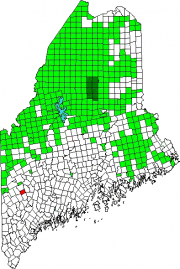
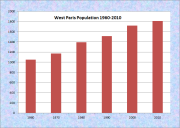

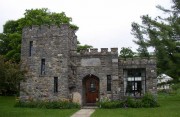
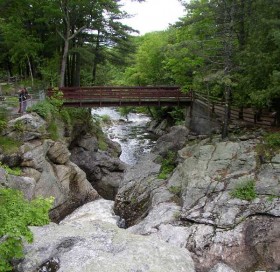
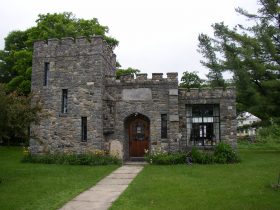
Is the sterns hill farm open to the public?